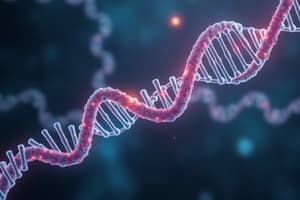Podcast
Questions and Answers
Which statement accurately describes the components of a nucleotide?
Which statement accurately describes the components of a nucleotide?
- It includes a pentose sugar, a nitrogenous base, and a phosphate. (correct)
- It consists of a nitrogenous base, a hexose sugar, and a phosphate group.
- It is made of a ribose sugar, a nitrogenous base, and a carboxyl group.
- It contains a simple sugar, a double ring base, and a sulfate.
What distinguishes DNA from RNA?
What distinguishes DNA from RNA?
- The sugar in DNA is ribose, while RNA contains deoxyribose.
- DNA is single-stranded, while RNA is double-stranded.
- DNA contains uracil, while RNA contains thymine.
- DNA uses thymine as a base, while RNA uses uracil. (correct)
What structural feature of DNA relates to its antiparallel nature?
What structural feature of DNA relates to its antiparallel nature?
- The two strands run in opposite directions, 5' to 3' on both strands. (correct)
- The hydrogen bonds between bases are identical in length.
- The sugar-phosphate backbone is arranged in a parallel fashion.
- The nitrogenous bases are arranged side by side without pairing.
How are the nitrogenous bases in DNA paired?
How are the nitrogenous bases in DNA paired?
Which of the following is true regarding the structure of DNA?
Which of the following is true regarding the structure of DNA?
Flashcards
What is DNA?
What is DNA?
DNA is a nucleic acid that carries the genetic instructions for an organism's development, function, and reproduction. It is a polymer made of repeating nucleotide units.
What are the parts of a nucleotide?
What are the parts of a nucleotide?
A nucleotide consists of three parts: a sugar (deoxyribose in DNA and ribose in RNA), a phosphate group, and a nitrogenous base.
What are the base pairing rules in DNA?
What are the base pairing rules in DNA?
In DNA, the bases adenine (A) pairs with thymine (T), and guanine (G) pairs with cytosine (C).
What are the nitrogenous bases in DNA and RNA?
What are the nitrogenous bases in DNA and RNA?
Signup and view all the flashcards
What is the structure of DNA?
What is the structure of DNA?
Signup and view all the flashcards
Study Notes
Nucleic Acids Study Guide
- DNA (deoxyribonucleic acid) stores genetic information for an organism's development and function
- DNA and RNA are nucleic acids
- Nucleotides are the repeating monomers of DNA and RNA
- Each nucleotide consists of a pentose sugar, phosphate, and a nitrogenous base
- DNA nucleotides have adenine (A), guanine (G), cytosine (C), and thymine (T) for bases
- RNA nucleotides have adenine (A), guanine (G), cytosine (C), and uracil (U) for bases
- Pyrimidines (single-ring): cytosine (C), thymine (T), and uracil (U)
- Purines (double-ring): adenine (A) and guanine (G)
- DNA's structure is a double helix
- Sugars and phosphates form the backbone
- Bases pair in the center (A with T, G with C)
- DNA strands are antiparallel (5' to 3' and 3' to 5')
- RNA is typically single-stranded
- RNA uses ribose sugar instead of deoxyribose
- Students should know the molecular structures of deoxyribose, ribose, nucleotide, DNA, and RNA
Additional Notes
- Compare and contrast DNA and RNA structures
- Be prepared to draw molecular structures (no carbon labeling required)
Studying That Suits You
Use AI to generate personalized quizzes and flashcards to suit your learning preferences.




